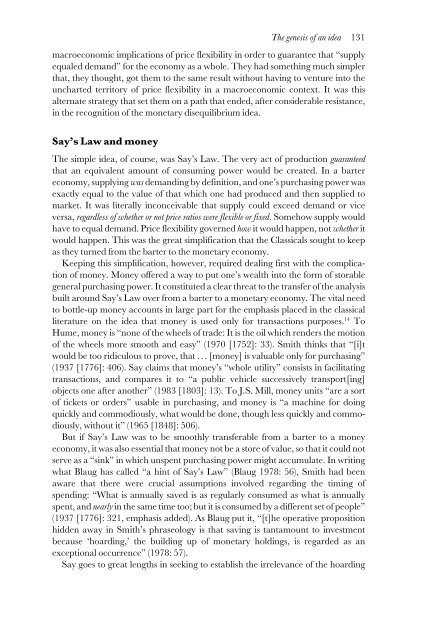Money and Markets: Essays in Honor of Leland B. Yeager
Money and Markets: Essays in Honor of Leland B. Yeager
Money and Markets: Essays in Honor of Leland B. Yeager
You also want an ePaper? Increase the reach of your titles
YUMPU automatically turns print PDFs into web optimized ePapers that Google loves.
The genesis <strong>of</strong> an idea 131macroeconomic implications <strong>of</strong> price flexibility <strong>in</strong> order to guarantee that “supplyequaled dem<strong>and</strong>” for the economy as a whole. They had someth<strong>in</strong>g much simplerthat, they thought, got them to the same result without hav<strong>in</strong>g to venture <strong>in</strong>to theuncharted territory <strong>of</strong> price flexibility <strong>in</strong> a macroeconomic context. It was thisalternate strategy that set them on a path that ended, after considerable resistance,<strong>in</strong> the recognition <strong>of</strong> the monetary disequilibrium idea.Say’s Law <strong>and</strong> moneyThe simple idea, <strong>of</strong> course, was Say’s Law. The very act <strong>of</strong> production guaranteedthat an equivalent amount <strong>of</strong> consum<strong>in</strong>g power would be created. In a bartereconomy, supply<strong>in</strong>g was dem<strong>and</strong><strong>in</strong>g by def<strong>in</strong>ition, <strong>and</strong> one’s purchas<strong>in</strong>g power wasexactly equal to the value <strong>of</strong> that which one had produced <strong>and</strong> then supplied tomarket. It was literally <strong>in</strong>conceivable that supply could exceed dem<strong>and</strong> or viceversa, regardless <strong>of</strong> whether or not price ratios were flexible or fixed. Somehow supply wouldhave to equal dem<strong>and</strong>. Price flexibility governed how it would happen, not whether itwould happen. This was the great simplification that the Classicals sought to keepas they turned from the barter to the monetary economy.Keep<strong>in</strong>g this simplification, however, required deal<strong>in</strong>g first with the complication<strong>of</strong> money. <strong>Money</strong> <strong>of</strong>fered a way to put one’s wealth <strong>in</strong>to the form <strong>of</strong> storablegeneral purchas<strong>in</strong>g power. It constituted a clear threat to the transfer <strong>of</strong> the analysisbuilt around Say’s Law over from a barter to a monetary economy. The vital needto bottle-up money accounts <strong>in</strong> large part for the emphasis placed <strong>in</strong> the classicalliterature on the idea that money is used only for transactions purposes. 14 ToHume, money is “none <strong>of</strong> the wheels <strong>of</strong> trade: It is the oil which renders the motion<strong>of</strong> the wheels more smooth <strong>and</strong> easy” (1970 [1752]: 33). Smith th<strong>in</strong>ks that “[i]twould be too ridiculous to prove, that . . . [money] is valuable only for purchas<strong>in</strong>g”(1937 [1776]: 406). Say claims that money’s “whole utility” consists <strong>in</strong> facilitat<strong>in</strong>gtransactions, <strong>and</strong> compares it to “a public vehicle successively transport[<strong>in</strong>g]objects one after another” (1983 [1803]: 13). To J.S. Mill, money units “are a sort<strong>of</strong> tickets or orders” usable <strong>in</strong> purchas<strong>in</strong>g, <strong>and</strong> money is “a mach<strong>in</strong>e for do<strong>in</strong>gquickly <strong>and</strong> commodiously, what would be done, though less quickly <strong>and</strong> commodiously,without it” (1965 [1848]: 506).But if Say’s Law was to be smoothly transferable from a barter to a moneyeconomy, it was also essential that money not be a store <strong>of</strong> value, so that it could notserve as a “s<strong>in</strong>k” <strong>in</strong> which unspent purchas<strong>in</strong>g power might accumulate. In writ<strong>in</strong>gwhat Blaug has called “a h<strong>in</strong>t <strong>of</strong> Say’s Law” (Blaug 1978: 56), Smith had beenaware that there were crucial assumptions <strong>in</strong>volved regard<strong>in</strong>g the tim<strong>in</strong>g <strong>of</strong>spend<strong>in</strong>g: “What is annually saved is as regularly consumed as what is annuallyspent, <strong>and</strong> nearly <strong>in</strong> the same time too; but it is consumed by a different set <strong>of</strong> people”(1937 [1776]: 321, emphasis added). As Blaug put it, “[t]he operative propositionhidden away <strong>in</strong> Smith’s phraseology is that sav<strong>in</strong>g is tantamount to <strong>in</strong>vestmentbecause ‘hoard<strong>in</strong>g,’ the build<strong>in</strong>g up <strong>of</strong> monetary hold<strong>in</strong>gs, is regarded as anexceptional occurrence” (1978: 57).Say goes to great lengths <strong>in</strong> seek<strong>in</strong>g to establish the irrelevance <strong>of</strong> the hoard<strong>in</strong>g
















